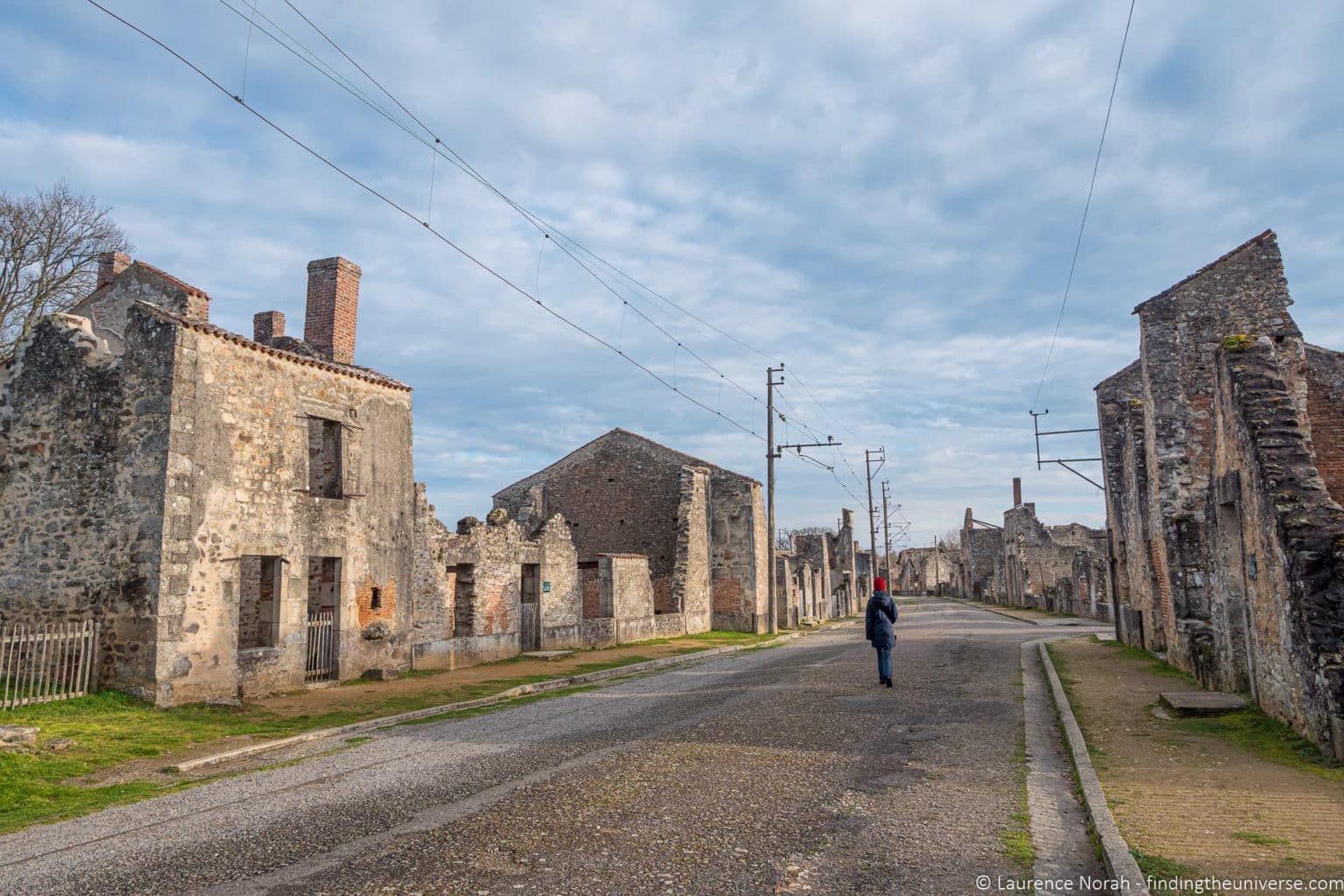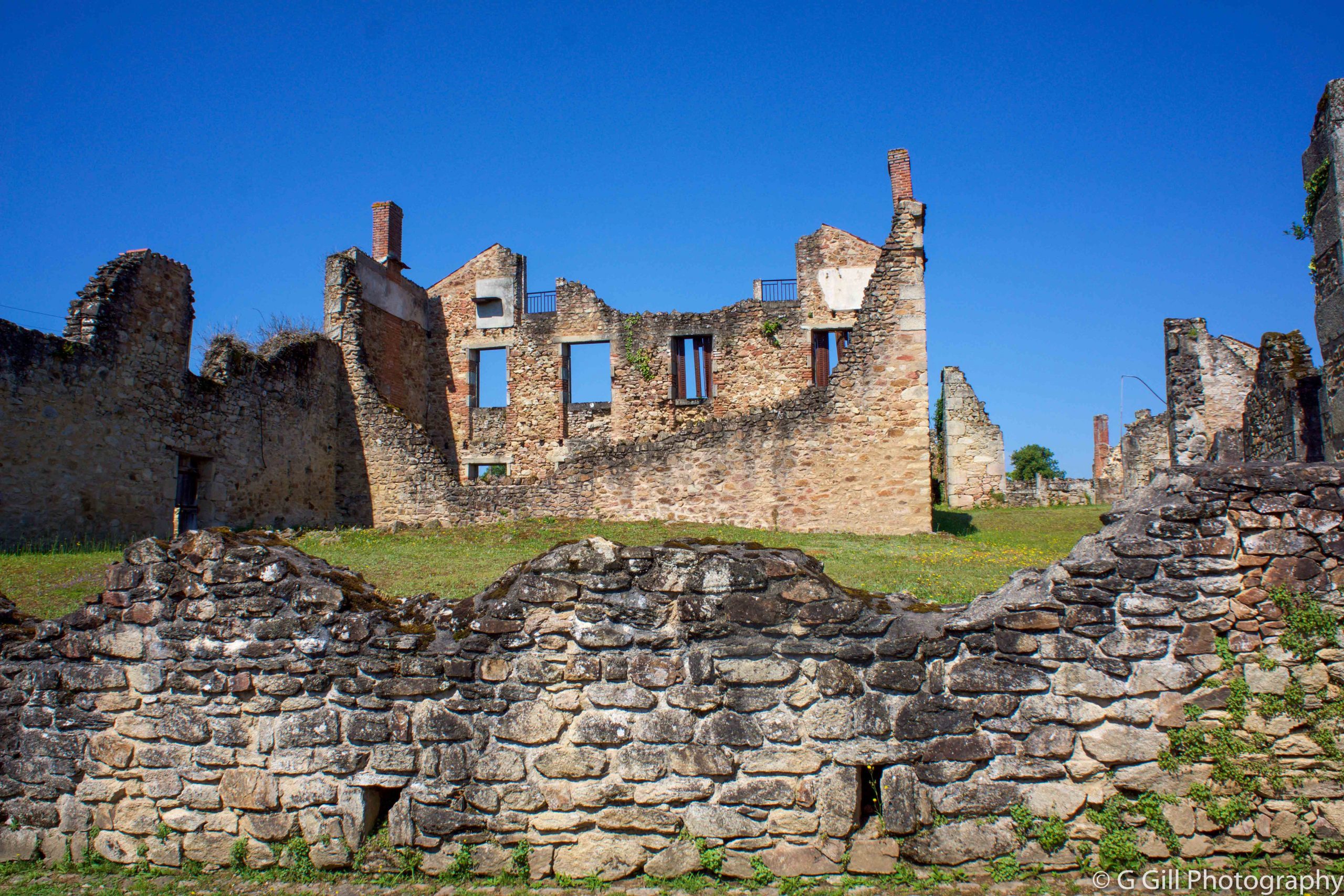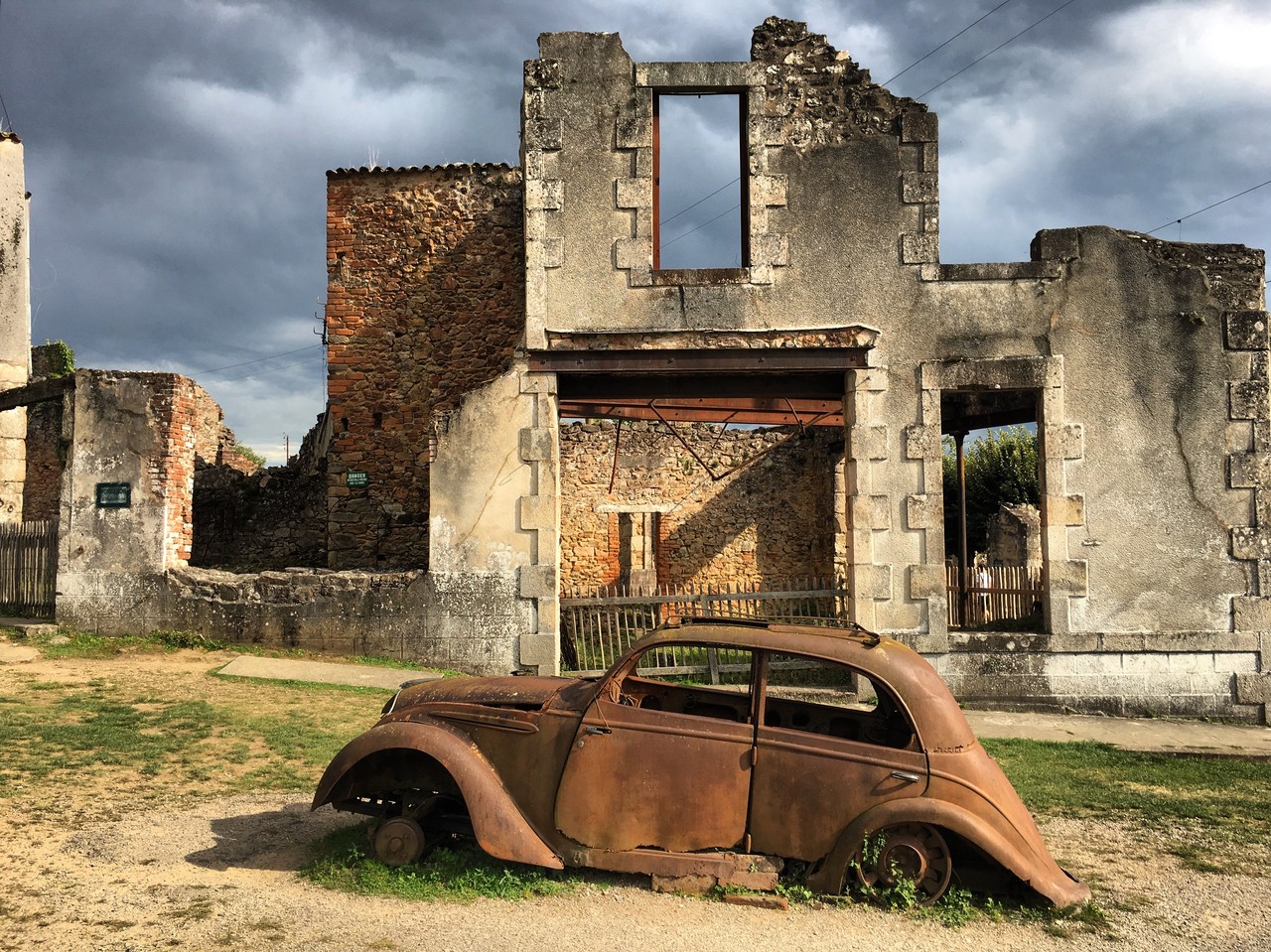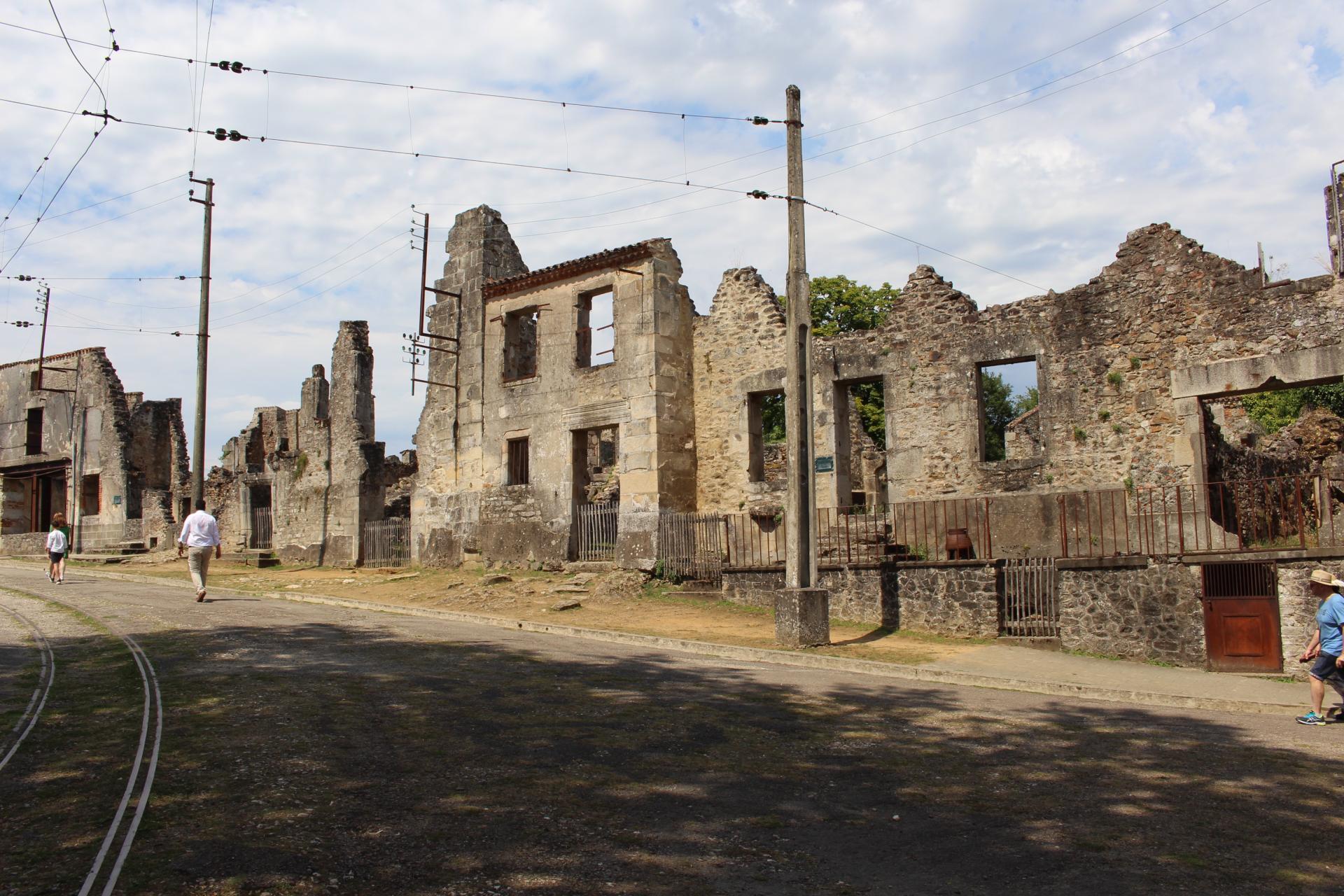Step into the chilling history of Oradour-sur-Glane, a French village forever scarred by the horrors of World War II. On a fateful day in 1944, Nazi soldiers descended upon this innocent town, leaving behind a legacy of unspeakable suffering and a poignant reminder of the darkest depths of human cruelty.
The massacre of Oradour-sur-Glane stands as a testament to the horrors of war and the fragility of human life. As we delve into the events of that tragic day, we’ll explore the historical context, the motivations of the perpetrators, and the lasting impact on the victims, their families, and the world.
Historical Significance

The Oradour-sur-Glane massacre, an appalling act of barbarism during World War II, holds profound historical significance.
On June 10, 1944, a Nazi SS battalion brutally murdered 642 civilians, including 245 children, in the French village of Oradour-sur-Glane. This heinous crime stands as a stark reminder of the horrors of war and the devastating impact of hatred and intolerance.
Impact on the Local Population
The massacre left an unfathomable scar on the people of Oradour-sur-Glane. The loss of life, the destruction of property, and the trauma inflicted upon the survivors cast a long shadow over the community.
In the aftermath, the village was left in ruins, a poignant testament to the savagery that had unfolded. The physical and psychological wounds took generations to heal, as the survivors grappled with the memories of that fateful day.
Despite the passage of time, the scars of Oradour-sur-Glane remain etched in the collective memory of its people. The village serves as a poignant reminder of the fragility of life and the importance of cherishing peace.
Expand your understanding about Renaud Van Ruymbeke with the sources we offer.
Post-War Investigation and Justice

In the aftermath of the Oradour-sur-Glane massacre, extensive investigations and trials were conducted to bring the perpetrators to justice. The process was fraught with challenges, including the gathering of evidence and the prosecution of those responsible.
Challenges in Gathering Evidence and Prosecution
- The massacre took place in a remote area, and many witnesses were killed or had fled.
- The perpetrators were well-organized and took steps to conceal their identities.
- Political interference and witness intimidation hampered the investigation.
The Village Today
Oradour-sur-Glane stands today as a preserved historical site, a solemn reminder of the horrors of war and the fragility of human life. The ruins of the village have been left untouched, serving as a poignant testament to the tragic events of June 10, 1944.
Preservation and Commemoration
Extensive efforts have been made to preserve the ruins of Oradour-sur-Glane and commemorate the victims of the massacre. The site has been designated a national historical monument, ensuring its protection and preservation for future generations. The ruined buildings, including the church, school, and homes, have been carefully stabilized and maintained, allowing visitors to witness firsthand the devastation wrought upon the village.
Tourism and Education
Tourism plays a vital role in raising awareness about the Oradour-sur-Glane massacre. Visitors from around the world come to the village to learn about the tragedy and pay their respects to the victims. Guided tours are available, providing visitors with detailed accounts of the events and the aftermath.
Educational programs are also conducted at the site, aiming to teach younger generations about the horrors of war and the importance of tolerance and understanding. School groups and students visit Oradour-sur-Glane to learn about the massacre and its historical significance, fostering a deeper understanding of the consequences of hatred and violence.
Cultural and Artistic Representations: Oradour-sur-Glane
The massacre at Oradour-sur-Glane has left an enduring mark on the world’s conscience. In the decades since the tragedy, it has been the subject of numerous literary works, films, and other artistic representations.
Literary Works
One of the most acclaimed literary works about Oradour-sur-Glane is “Oradour” (1947) by Marguerite Duras. The novel tells the story of a group of villagers who are rounded up and massacred by the Nazis. Duras’s vivid prose and evocative imagery bring the horrors of the massacre to life, creating a powerful and moving account of the event.
Other notable literary works about Oradour-sur-Glane include “The Village of Shadows” (1947) by Claude Roy, “The Ashes of Oradour” (1948) by Louis Aragon, and “Oradour” (2002) by Michel Braudeau.
Films
Several films have also been made about Oradour-sur-Glane. One of the most well-known is “Oradour-sur-Glane” (1976) by Robert Enrico. The film tells the story of the massacre through the eyes of a young boy who survived the tragedy. Enrico’s film is a powerful and moving account of the event, and it has helped to raise awareness of the massacre around the world.
Other notable films about Oradour-sur-Glane include “The Silence of the Lambs” (1991) by Jonathan Demme, “Schindler’s List” (1993) by Steven Spielberg, and “Inglourious Basterds” (2009) by Quentin Tarantino.
Other Artistic Representations
In addition to literary works and films, Oradour-sur-Glane has also been the subject of other artistic representations, such as paintings, sculptures, and memorials. These works of art have helped to keep the memory of the massacre alive and to ensure that the victims are never forgotten.
One of the most famous paintings of Oradour-sur-Glane is “The Massacre at Oradour” (1945) by Pablo Picasso. The painting depicts the horrors of the massacre in a powerful and moving way. Other notable paintings of Oradour-sur-Glane include “The Village of the Dead” (1945) by Marc Chagall and “Oradour” (1946) by Jean Dubuffet.
Several sculptures have also been created to commemorate the massacre at Oradour-sur-Glane. One of the most famous is “The Monument to the Martyrs of Oradour-sur-Glane” (1953) by Jacques Danos. The monument is a powerful and moving tribute to the victims of the massacre.
Educational Resources and Outreach
Educational materials and resources related to Oradour-sur-Glane play a crucial role in preserving the memory of the massacre and educating future generations about its significance. Schools and universities have a responsibility to teach about this tragic event to promote historical literacy and prevent similar atrocities from happening again.
Innovative Approaches to Student Engagement
Innovative approaches to engaging students and promoting historical literacy include interactive online exhibits, virtual reality experiences, and immersive simulations. These methods allow students to connect with the past in a more personal and meaningful way, fostering a deeper understanding of the events and their impact.
The Role of Museums and Memorials
Museums and memorials play a pivotal role in preserving the memory of Oradour-sur-Glane and the horrors that transpired there. They serve as tangible reminders of the tragedy, fostering remembrance and understanding among visitors.
Creating meaningful and respectful spaces for commemoration presents both challenges and opportunities. Museums and memorials must strike a balance between preserving the authenticity of the site while creating an accessible and engaging experience for visitors. This involves careful consideration of the physical environment, the selection and display of artifacts, and the use of interpretive materials.
Interactive Exhibits and Technology
Museums and memorials are increasingly incorporating technology and interactive exhibits to enhance visitor experiences. These tools can provide additional context, allow visitors to explore the site at their own pace, and create a more immersive and emotionally resonant connection to the history of Oradour-sur-Glane.
- Virtual reality experiences can transport visitors back in time, allowing them to witness the events of the massacre firsthand.
- Interactive touchscreens provide access to archival documents, photographs, and oral histories, deepening visitors’ understanding of the tragedy.
- Augmented reality apps can overlay historical images and information onto the present-day landscape, bridging the gap between the past and present.
Ethical Considerations in Commemoration
Commemorating traumatic events poses ethical considerations that require careful navigation. Striking a balance between preserving historical accuracy and respecting the victims and their families is crucial. Empathy and compassion should guide commemorative practices to avoid retraumatization or glorification of violence.
Balancing Historical Accuracy and Respect
Commemorations should accurately depict the event without sensationalizing or distorting it. However, it is essential to consider the perspectives of victims and their families, who may have varying levels of comfort with the details being shared.
Empathy and Compassion
Commemorations should foster empathy and compassion for the victims. This can be achieved through personal testimonies, interactive exhibits, and educational programs that humanize the victims and their experiences.
Risks and Benefits of Commemoration
Commemorations can potentially retraumatize survivors or glorify violence. However, they can also promote healing, raise awareness, and prevent similar events from happening again.
Ethical Guidelines for Commemoration
To ensure ethical and respectful commemoration, guidelines should be established. These guidelines should consider the perspectives of victims, families, and the broader community.
Discover how PWHL Draft 2024 has transformed methods in RELATED FIELD.
Art and Creative Expression in Commemoration
Art and creative expression can play a powerful role in promoting empathy and understanding. Commemorative artworks can evoke emotions, stimulate reflection, and provide a platform for dialogue.
Ethical Implications of Political or Commercial Use
Commemorative events should not be used for political or commercial purposes. This can undermine their integrity and exploit the suffering of victims for personal or financial gain.
International Perspectives and Collaboration

The Oradour-sur-Glane massacre resonated deeply not only within France but also internationally. The event sparked widespread condemnation and became a symbol of the horrors of war and the fragility of human life.
Collaborative Efforts
In the aftermath of the massacre, international organizations and institutions played a crucial role in addressing the legacy of violence and promoting reconciliation. The United Nations Educational, Scientific and Cultural Organization (UNESCO) designated Oradour-sur-Glane as a World Heritage Site in 1999, recognizing its significance as a reminder of the atrocities committed during World War II.
Moreover, collaborative efforts have been undertaken to foster dialogue and understanding between France and Germany. In 1984, French President François Mitterrand and German Chancellor Helmut Kohl held a joint commemoration ceremony at Oradour-sur-Glane, symbolizing the reconciliation between the two nations.
– Provide specific examples of ongoing violence and the challenges faced in reconciliation efforts.
Ongoing violence and conflicts present significant challenges to reconciliation efforts worldwide. One notable example is the ongoing conflict in the Middle East, where decades of violence and political instability have made reconciliation a daunting task. Another example is the persistent violence in parts of Africa, where ethnic conflicts, civil wars, and terrorism continue to hinder reconciliation efforts.
The challenges faced in reconciliation efforts are multifaceted and include the following:
- Lack of political will: Political leaders may be reluctant to engage in reconciliation efforts due to fear of losing power or facing backlash from their constituents.
- Impunity: Perpetrators of violence may not be held accountable for their actions, which can undermine trust and prevent victims from moving forward.
- Historical revisionism: Attempts to rewrite or distort the history of violence can hinder reconciliation by preventing a shared understanding of the past.
- Economic inequality: Disparities in wealth and resources can create resentment and make reconciliation difficult.
Archaeological Research and Discoveries
Archaeological research at Oradour-sur-Glane has played a crucial role in uncovering the horrors of the massacre and providing insights into the events that transpired.
Methods and Techniques
Archaeologists have employed a range of methods and techniques at Oradour-sur-Glane, including:
- Excavations: Careful excavation of the site has revealed the remains of buildings, artifacts, and human remains, providing valuable evidence about the massacre and the lives of the victims.
- Geophysical surveys: These surveys have been used to map the site and identify areas of potential interest for further excavation.
- Forensic analysis: Forensic experts have examined human remains to determine the cause of death and identify victims.
- Historical research: Archaeologists have consulted historical documents, such as witness accounts and military records, to supplement their findings.
Findings and Contribution, Oradour-sur-Glane
Archaeological research at Oradour-sur-Glane has yielded significant findings that have contributed to our understanding of the massacre, including:
- Identification of victims: Forensic analysis has helped identify the remains of over 500 victims, allowing for the identification and burial of the deceased.
- Reconstruction of events: The excavation of buildings and the analysis of artifacts have provided insights into the sequence of events during the massacre, including the locations of executions and the methods used by the perpetrators.
- Evidence of violence: The discovery of mass graves and the presence of bullet holes and other injuries on human remains have provided irrefutable evidence of the brutality of the massacre.
Challenges and Opportunities
Conducting archaeological investigations at Oradour-sur-Glane presents unique challenges and opportunities:
- Ethical considerations: The site is a sensitive memorial and requires careful excavation techniques to preserve the remains and artifacts respectfully.
- Preservation of evidence: The preservation of evidence is crucial for future research and to ensure the accuracy of the historical record.
- Opportunities for research: The site provides a wealth of information for archaeologists to study the massacre, its aftermath, and the broader history of the Second World War.
Key Findings and Implications
The key findings from archaeological research at Oradour-sur-Glane have significant implications for our understanding of the massacre and its aftermath:
- Confirmation of the massacre: Archaeological evidence has confirmed the extent and brutality of the massacre, providing undeniable proof of the atrocities committed.
- Impact on the community: The research has helped to shed light on the impact of the massacre on the local community and the long-term consequences for survivors and their descendants.
- Historical significance: The archaeological findings have contributed to a deeper understanding of the Second World War and the nature of Nazi atrocities.
Comparative Analysis of Massacres
The tragedy of Oradour-sur-Glane was not an isolated incident but part of a larger pattern of mass violence that has plagued humanity throughout history. By comparing it to other massacres, we can identify commonalities in their causes, perpetrators, and consequences, and gain insights into the dynamics of mass atrocities.
Perpetrators and Motives
- Oradour-sur-Glane was perpetrated by the Nazi Waffen-SS, motivated by a combination of ideological hatred, reprisal, and the desire to terrorize the local population.
- Other massacres, such as the Nanjing Massacre (1937) and the Srebrenica Massacre (1995), were also carried out by military forces motivated by similar ideologies of hatred, fear, and ethnic cleansing.
Victims and Targeting
- In Oradour-sur-Glane, the victims were primarily civilians, including women, children, and the elderly, who were targeted indiscriminately.
- Similarly, in the Rwandan Genocide (1994), civilians were specifically targeted based on their ethnic identity, leading to the deaths of hundreds of thousands.
Escalation and Prevention
- The escalation of violence in Oradour-sur-Glane was fueled by a cycle of fear, retaliation, and propaganda.
- In other massacres, such as the Holocaust (1941-1945), the escalation of violence was often enabled by the failure of international intervention and the complicity of bystanders.
Consequences and Legacy
- The massacre at Oradour-sur-Glane left a lasting legacy of trauma, grief, and division within the community.
- Other massacres, such as the Armenian Genocide (1915-1923), have had similar long-term consequences, including the displacement of populations, the destruction of cultural heritage, and the ongoing struggle for recognition and justice.
– Discuss the importance of memory and remembrance in understanding and preventing mass violence, providing specific examples from the case of Oradour-sur-Glane.

Memory and remembrance play a crucial role in understanding and preventing mass violence. By remembering and learning from past atrocities, we can identify patterns, understand the motivations behind them, and develop strategies to prevent their recurrence.
The case of Oradour-sur-Glane provides a poignant example of the importance of memory and remembrance. The village was destroyed by Nazi forces in 1944, resulting in the deaths of over 600 innocent civilians. The ruins of the village have been preserved as a memorial to the victims, and the story of Oradour-sur-Glane is taught in schools throughout France.
By remembering and learning from the tragedy of Oradour-sur-Glane, we can help to prevent similar atrocities from happening in the future. We can identify the warning signs of mass violence, and we can develop strategies to intervene and stop it before it occurs.
Examples of the importance of memory and remembrance in understanding and preventing mass violence
- The Holocaust: The memory of the Holocaust has helped to raise awareness of the dangers of anti-Semitism and racism, and it has led to the development of international laws and institutions to prevent genocide.
- The Rwandan Genocide: The memory of the Rwandan Genocide has helped to raise awareness of the dangers of ethnic hatred and division, and it has led to the development of new strategies for preventing and responding to mass violence.
- The Srebrenica Massacre: The memory of the Srebrenica Massacre has helped to raise awareness of the dangers of ethnic cleansing and war crimes, and it has led to the development of new international laws and institutions to protect civilians during wartime.
Educational Resources and Initiatives

Oradour-sur-Glane serves as a poignant reminder of the horrors of war and the importance of historical understanding to prevent future atrocities. Various educational resources and initiatives have emerged to promote a deeper understanding of the massacre and its implications.
One key resource is the Centre de la Mémoire d’Oradour (Oradour Memorial Center), which offers guided tours of the preserved village ruins, exhibitions, and educational programs. These programs aim to provide visitors with a comprehensive understanding of the events of June 10, 1944, and their historical context.
School Curricula
The massacre of Oradour-sur-Glane has been incorporated into the history curricula of several countries, including France, Germany, and the United Kingdom. By integrating the event into educational materials, students are exposed to the horrors of war and the importance of tolerance and understanding.
In France, for instance, the massacre is taught as part of the national history curriculum, emphasizing the Nazi occupation and its devastating impact on French civilians.
International Collaborations
International collaborations have also played a significant role in promoting education about Oradour-sur-Glane. The International School for the Study of the Holocaust, Yad Vashem, and the International Association of Historians of Genocide have organized conferences, workshops, and teacher training programs to foster a deeper understanding of the massacre and its implications for genocide prevention.
These initiatives aim to equip educators with the knowledge and resources to effectively teach about the Holocaust and other genocides, including the massacre at Oradour-sur-Glane.
Innovative Approaches
In addition to traditional educational methods, innovative approaches have been employed to engage students and the public with the history of Oradour-sur-Glane.
- Virtual reality experiences allow visitors to immerse themselves in the village as it was before the massacre, providing a visceral connection to the event.
- Interactive online platforms offer interactive timelines, historical documents, and personal testimonies, making the history of Oradour-sur-Glane accessible to a wider audience.
- Artistic installations and performances have also been used to convey the emotions and experiences of the victims, fostering empathy and understanding.
Effectiveness and Challenges
While educational resources and initiatives have made significant contributions to historical understanding and awareness, challenges remain.
- Ensuring the accuracy and objectivity of educational materials is crucial to prevent the distortion or trivialization of historical events.
- Reaching a wider audience beyond those already interested in the subject remains a challenge, particularly in contexts where historical revisionism or denial is prevalent.
- Balancing the need to educate about the horrors of war with the potential for emotional distress and trauma among learners requires careful consideration.
Final Review

Oradour-sur-Glane serves as a chilling reminder of the horrors that humanity is capable of. Its ruins stand as a solemn testament to the victims and a stark warning against the dangers of hatred, intolerance, and the destructive power of war. By remembering and learning from this tragedy, we honor the memory of those who perished and strive to create a world where such atrocities never happen again.
